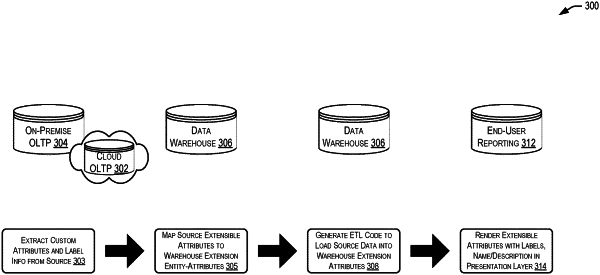| CPC G06F 16/254 (2019.01) | 21 Claims |

|
1. A method, comprising:
reserving, in a data warehouse table, a first set of extension columns, the data warehouse table containing a plurality of initial columns;
receiving metadata from a customer source, the metadata identifying an attribute for the data warehouse table;
extracting the attribute from the metadata;
determining that the attribute from the metadata does not correspond to a column of the plurality of initial columns in the data warehouse table;
responsive to determining that the attribute does not correspond to a column of the plurality of initial columns, comparing a data type corresponding to the attribute from the metadata of the customer source to a data type of a next unallocated column in the first set of extension columns from the data warehouse table;
based at least in part on the comparing, selecting the first set of extension columns in the data warehouse table for mapping based at least in part on the next unallocated column having:
(a) matching metadata code indicating matching column properties between a source property corresponding to the attribute and a target property corresponding to the next unallocated column; and
(b) a match between the data type of the next unallocated column in the first set of extension columns and the data type corresponding to the attribute;
generating code to map the attribute to the next unallocated column based at least in part on the metadata from the customer source;
mapping the attribute to the next unallocated column based at least in part on the generated code; and
executing instructions to move data associated with the attribute into the next unallocated column of the data warehouse table.
|